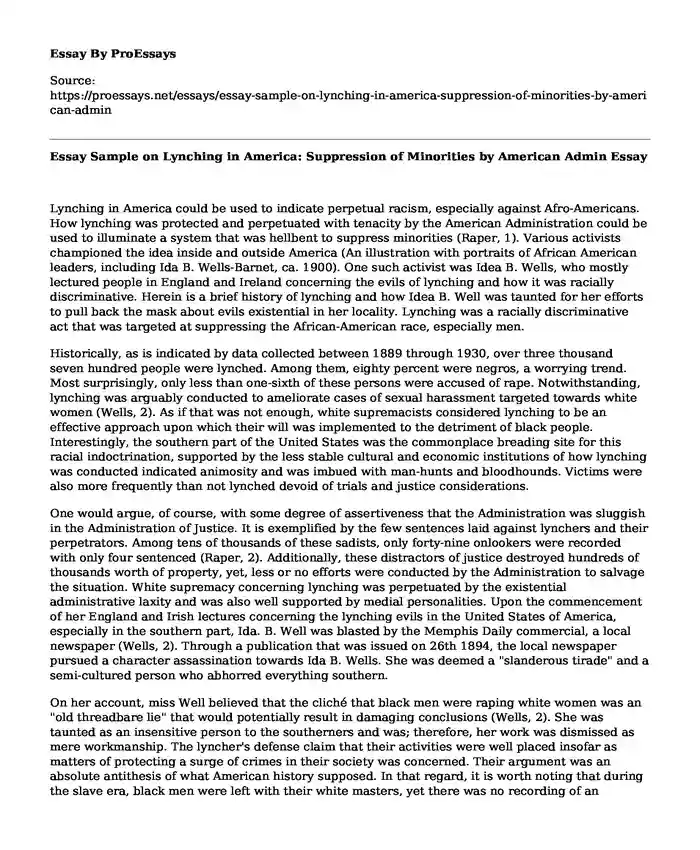Lynching in America could be used to indicate perpetual racism, especially against Afro-Americans. How lynching was protected and perpetuated with tenacity by the American Administration could be used to illuminate a system that was hellbent to suppress minorities (Raper, 1). Various activists championed the idea inside and outside America (An illustration with portraits of African American leaders, including Ida B. Wells-Barnet, ca. 1900). One such activist was Idea B. Wells, who mostly lectured people in England and Ireland concerning the evils of lynching and how it was racially discriminative. Herein is a brief history of lynching and how Idea B. Well was taunted for her efforts to pull back the mask about evils existential in her locality. Lynching was a racially discriminative act that was targeted at suppressing the African-American race, especially men.
Historically, as is indicated by data collected between 1889 through 1930, over three thousand seven hundred people were lynched. Among them, eighty percent were negros, a worrying trend. Most surprisingly, only less than one-sixth of these persons were accused of rape. Notwithstanding, lynching was arguably conducted to ameliorate cases of sexual harassment targeted towards white women (Wells, 2). As if that was not enough, white supremacists considered lynching to be an effective approach upon which their will was implemented to the detriment of black people. Interestingly, the southern part of the United States was the commonplace breading site for this racial indoctrination, supported by the less stable cultural and economic institutions of how lynching was conducted indicated animosity and was imbued with man-hunts and bloodhounds. Victims were also more frequently than not lynched devoid of trials and justice considerations.
One would argue, of course, with some degree of assertiveness that the Administration was sluggish in the Administration of Justice. It is exemplified by the few sentences laid against lynchers and their perpetrators. Among tens of thousands of these sadists, only forty-nine onlookers were recorded with only four sentenced (Raper, 2). Additionally, these distractors of justice destroyed hundreds of thousands worth of property, yet, less or no efforts were conducted by the Administration to salvage the situation. White supremacy concerning lynching was perpetuated by the existential administrative laxity and was also well supported by medial personalities. Upon the commencement of her England and Irish lectures concerning the lynching evils in the United States of America, especially in the southern part, Ida. B. Well was blasted by the Memphis Daily commercial, a local newspaper (Wells, 2). Through a publication that was issued on 26th 1894, the local newspaper pursued a character assassination towards Ida B. Wells. She was deemed a "slanderous tirade" and a semi-cultured person who abhorred everything southern.
On her account, miss Well believed that the cliché that black men were raping white women was an "old threadbare lie" that would potentially result in damaging conclusions (Wells, 2). She was taunted as an insensitive person to the southerners and was; therefore, her work was dismissed as mere workmanship. The lyncher's defense claim that their activities were well placed insofar as matters of protecting a surge of crimes in their society was concerned. Their argument was an absolute antithesis of what American history supposed. In that regard, it is worth noting that during the slave era, black men were left with their white masters, yet there was no recording of an instance where white women were violated (Well, 3). Rape accusations by white women could, therefore, be deemed a mere excuse upon which racial discrimination was perpetuated against Afro-Americans.
Conclusion
Lynching was an approach used by white supremacists to perpetuate racism in the United States of America. For far too long, lynching was used against black men. Both the administration and media personalities suppressed efforts to combat the societal vice. Activists were blasted in their efforts to expose the lynching evils. Therefore, lynching was a systemic endeavor aimed at putting whites against Afro-Americans and acting contrary to the attainment of free American society.
Works Cited
Ida B. Wells and Ant-Lynching Activism. An illustration with portraits of African American leaders including Ida B. Wells-Barnet, ca. 1900.
Raper, A.F. The tragedy of Lynching (1938). Chapel Hill, The University of North Carolina Press.
Wells, I.B. An address adopted by a mass meeting of an Afro-American citizen of St. Paul, Minnesota. (1894, June 11).
Cite this page
Essay Sample on Lynching in America: Suppression of Minorities by American Admin. (2023, Sep 15). Retrieved from https://proessays.net/essays/essay-sample-on-lynching-in-america-suppression-of-minorities-by-american-admin
If you are the original author of this essay and no longer wish to have it published on the ProEssays website, please click below to request its removal:
- Article Analysis Essay on Ending Africa's Poverty Trap
- Essay Sample on United States Border Patrol
- Essay Sample on Rape Kit Backlog
- Essay Sample on Critical Infrastructure Sector(s) and Bioterrorism
- Research Paper on Policing Methamphetamine: Narcopolitics in Rural America
- Essay on Drug Arrests: Uncovering Racial Disparities and Strategies to Minimize Inequities
- Sexism in Human Rights Discourse: Unmasking a Hidden Reality - Annotated Bibliography







